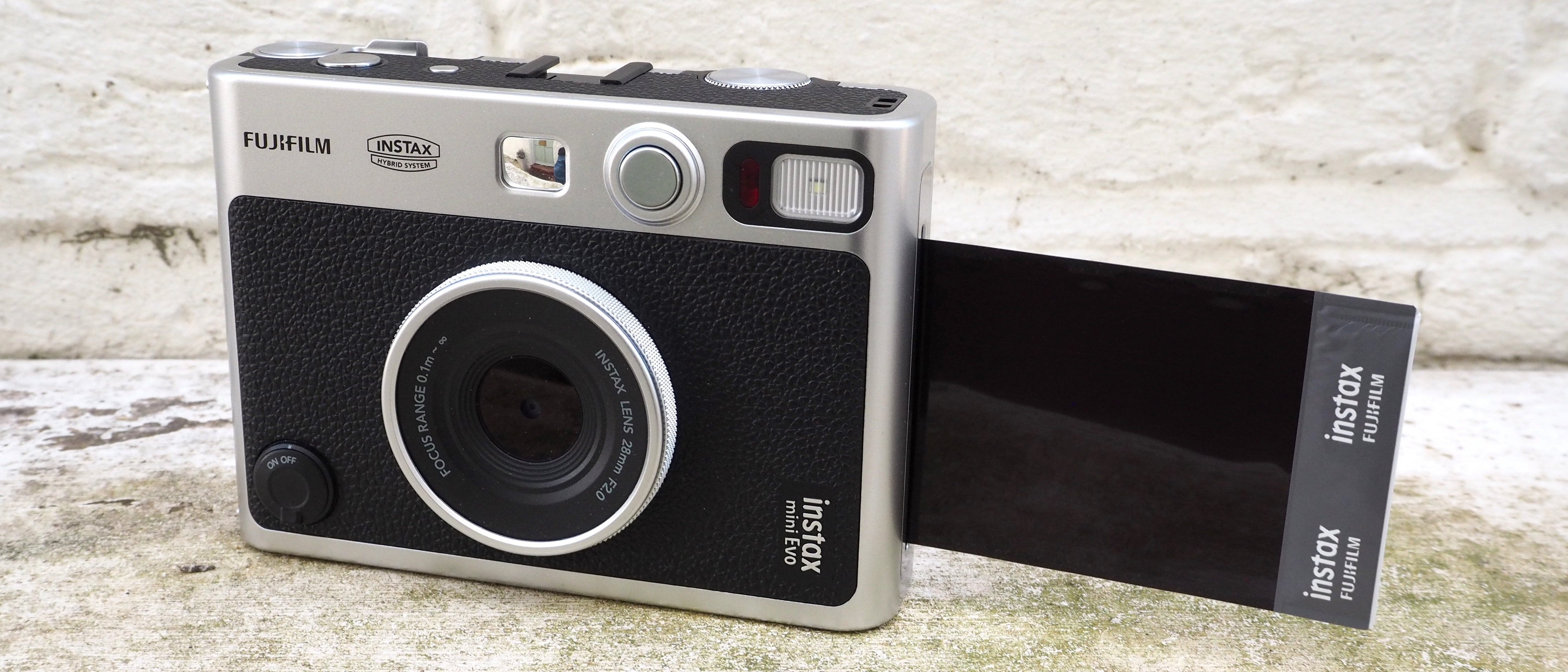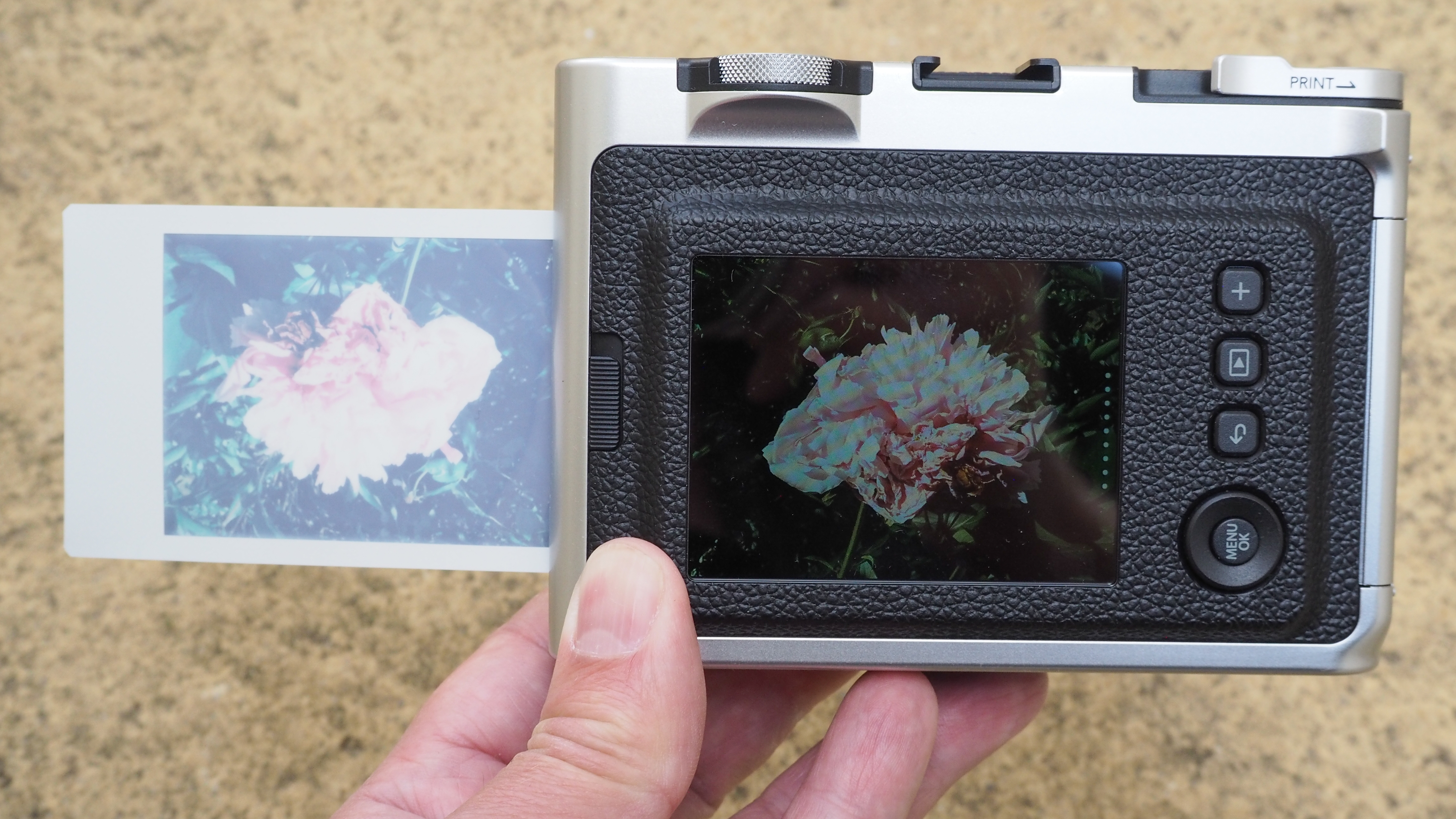Digital Camera World Verdict
If you're looking for one instant print camera that does it all – and you're satisfied with the digital-looking photographs from the device itself – then the Fujifilm Instax Mini Evo camera has much to recommend it. Once I’d discovered what all the unmarked buttons do it quickly became apparent that, unusually, this isn’t an instant print camera that I’ll rapidly become bored of. And that in my book makes it well worth the asking price.
Pros
- +
Best of digital and analog photography combined
- +
Risk-free printing: view shots before you hit print
- +
3-inch LCD allows for some editing
Cons
- -
Produces a "digital look", not an analog one
- -
Requires additional microSD card, not provided, to expand the internal memory
- -
Battery life lasts a modest 100 shots
Why you can trust Digital Camera World
Want an instant camera, but need an instant printer? The Instax Mini Evo promises the best of both worlds, enabling you to get a photograph instantly or choose and edit the shot you want to turn into a photo later – or even print one taken on phone.
The Instax Mini Evo is an ‘evolution’ of the original instant print idea, one could say. This is a digital camera with a back screen that enables you to compose and review shots and then only print the ones you’re happy with, rather than pointing and shooting and then praying that what you’ve got is good, before it materializes on the credit card-sized film sheets provided.
Instant print photography purists can of course argue that being able to review your shot before printing it takes some of the magic away. After all, the growing anticipation of what our picture looks like as our image slowly reveals itself over a minute-and-a-half– and the fact that, ironically, it is not quite truly instant – is part of the ‘fun’ of the instant print process.
However, the best instant cameras don’t typically feature a back screen (including the otherwise similarly retro-styled Instax Mini 40). So I’d wager this one is for the more practically minded who want the best of both – and there’s nothing wrong with that.
Instax Mini Evo: Specifications
Sensor: 2560x1920 pixels, 1/5-inch CMOS
Sensitivity range: ISO100 to ISO1600
Video: N/A
Lens: 28mm equivalent in 35mm terms, f/2.0
Monitor: 3-inch LCD, 460,000 dots
Viewfinder: N/A
Battery life: Up to 100 shots
Dimensions: 87x122.9x36mm
Weight: 285g
Instax Mini Evo: Key features
The hybrid approach here and inclusion of a three-inch back screen has ensured that the Instax Mini Evo can offer a bit more than the standard analog instant print point-and-shooter. Not only can certain images be selected for print after reviewing first; an amount of image editing can also be undertaken in-camera.
In fact, 10 integrated lens modes and 10 film modes can provide up to 100 different effects when combined, going some way to both ape and combat the image editing apps on our smartphones, should we want to.
The best camera deals, reviews, product advice, and unmissable photography news, direct to your inbox!
As well as an image capture device, the Evo can also act as a standalone portable printer, connectable to smartphones via Bluetooth, meaning that photos transmitted from your camera roll can be output as hard copies. It also means that shots can be transferred the other way, from the Evo to a smartphone, for sharing on social media or with friends and family. Truly its maker seems to be attempting to cover all bases and user requests with this one.
On top of this, the camera-come-printer claims to deliver the highest print quality of its manufacturer’s line-up so far at 600 dpi; when prints are made directly from the camera itself that is. Battery life is a claimed 100 shots, or 10 packs of Instax Mini film, which is modest compared to most digicams. Fortunately, then, its built-in power cell is readily rechargeable via a provided USB lead and an (optional) USB-compatible mains plug, or simply by sticking its USB lead into a spare port on your laptop. Charging takes up to three hours.
Also not supplied here is a microSD card for the storage of images, for which a slot is provided adjacent to that for the USB lead at the camera’s base. But then you don’t get a memory card provided when you buy a dedicated camera or phone, so it’s hardly a deal breaker. As it is, the camera boasts an internal storage capacity for up to 45 images to get you going out of the box.
At the heart of this camera is a half-inch CMOS sensor producing 4.9MP images, coupled with a fairly bright f/2.0 aperture, 28mm equivalent wide-angle lens in 35mm film terms. In tandem with an automatically switchable ISO range stretching between ISO100 and ISO1600, this suggests a device capable of doing the job in most lighting conditions. In more challenging scenarios there is also the ability to fall back on the built-in flash.

Instax Mini Evo: Build & handling
With its faux leather surfaces set against plastic-y silver surround, the Instax Mini Evo camera manages to look sufficiently retro to evoke pangs of nostalgia in prospective purchasers, while at the same time not overly confusing or fussy – which might otherwise perplex the smartphone generation expected to load analog film for the first time.
That said, in activating the camera via the commendably tactile power lever on the faceplate, you’re met with an almost overwhelming array of on-screen options – which meant that it took a couple of minutes to work out how to cut through all that and simply capture and output a photo. It should, after all, be as simple as pointing and shooting, as on competing purely analog instant cameras.
There are more external buttons than the average instant camera, too. Not only do we get a shutter release button on the top plate, but also a second one on the faceplate, next to a built-in mirror for the selfie-obsessed and a small lozenge-shaped window housing an integral flash.
Also on the top plate is a large ridged metal dial set flush to the body, which is unmarked but is a ‘film dial’ for selecting the ten different film effects promised up front. It then makes sense that turning the ridged lens dial surrounding the lens itself runs through the ten different lens settings. A further, smaller, likewise unmarked top plate button is a ‘reset’ button, for returning any lens and film effects to normal if it all gets a bit much.
Though a neck strap is handily provided in the box, what might also have been useful is a lens cap of any description to protect that element when the camera is being transported.
Instax Mini Evo: Performance
While credit card sized prints are at the heart of what the Instax Mini Evo delivers, the central picture portion is even smaller than that, due to the surrounding border (check out our guide to instant camera film sizes to see how all the formats compare). Color-wise, we get a selectable in-camera choice of standard natural or rich mode when it comes to prints – I chose the latter as I was looking for maximum impact, and aware that instant prints can sometimes look a bit flat and lacking in contrast.
Taking a picture involves a squeeze of the shutter release button, at which point the captured shot appears briefly on screen as you’d expect. Yet printing it out isn’t an instant process and involves a bit of theater – namely cranking the dedicated print lever on the top right-hand side of the camera while the image you want to print is displayed on screen at the same time.
If you don’t have the image on screen, then flipping the lever – as if to wind forward a roll of film in the old days – will achieve nothing. I did, however, admire the fact that the on-screen image becomes animated, and starts "ejecting" off the screen as the print starts emerging. It’s a nice visual touch.
In terms of performance, light sensitivity here ranges from a standard ISO100 to ISO1600 and is fully automatic, meaning that you can’t tweak the settings yourself. If I’ve got a gripe it’s that, while the provided LCD screen is a decent size, visibility inevitably suffers in sunlight, despite the decent 460,000-dot resolution.
One point worth making harks back to the 4.9MP CMOS sensor, with that ISO1600 top sensitivity: the photos taken by the Mini Evo are digital, and they look digital. They are bright and clear in a way that photos taken on analog cameras like the Instax Mini 12 and Mini 99 aren't, looking a lot like a phone photo that you've printed out and lacking that elusive "vintage" look. So if you're buying an instant camera for that analog film camera look, you'll probably want to look elsewhere.
Instax Mini Evo: Verdict

The Instax Mini Evo camera is an interesting hybrid product for a fair price that seeks to expand on the self-imposed limitations of an instant print camera that only outputs credit card-sized prints.
Yes, you can do that here, but you can also use it like a regular digital camera – and as an extension of your smartphone. In other words, Instax Fuji has attempted to deliver one device that does it all, and one that has serious gifting potential with it.
On top of this, all the extras over and above a ‘standard’ instant print camera should ensure that users don’t get bored of the novelty of it all as quickly as they may with a more basic, frill-free model. If you’re seeking ‘one instant print camera to rule them all’, look no further.
Gavin has over 30 years’ experience of writing about photography and television. He is currently the editor of British Photographic Industry News, and previously served as editor of Which Digital Camera and deputy editor of Total Digital Photography.
He has also written for a wide range of publications including T3, BBC Focus, Empire, NME, Radio Times, MacWorld, Computer Active, What Digital Camera and the Rough Guide books.
With his wealth of knowledge, Gavin is well placed to recognize great camera deals and recommend the best products in Digital Camera World’s buying guides. He also writes on a number of specialist subjects including binoculars and monoculars, spotting scopes, microscopes, trail cameras, action cameras, body cameras, filters and cameras straps.






